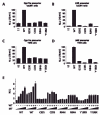Five novel mutations in steroidogenic factor 1 (SF1, NR5A1) in 46,XY patients with severe underandrogenization but without adrenal insufficiency
- PMID: 17694559
- PMCID: PMC2359628
- DOI: 10.1002/humu.20588
Five novel mutations in steroidogenic factor 1 (SF1, NR5A1) in 46,XY patients with severe underandrogenization but without adrenal insufficiency
Abstract
Steroidogenic factor 1 (SF1, NR5A1) is a nuclear receptor that regulates multiple genes involved in adrenal and gonadal development, steroidogenesis, and the reproductive axis. Human mutations in SF1 were initially found in two 46,XY female patients with severe gonadal dysgenesis and primary adrenal failure. However, more recent case reports have suggested that heterozygous mutations in SF1 may also be found in patients with 46,XY partial gonadal dysgenesis and underandrogenization but normal adrenal function. We have analyzed the gene encoding SF1 (NR5A1) in a cohort of 27 patients with 46,XY disorders of sex development (DSD) from the German network of DSD. Heterozygous SF1 mutations were found in 5 out of 27 (18.5%) of cases. Four patients with SF1 mutations presented with the similar phenotype of mild gonadal dysgenesis, severe underandrogenization, and absent Müllerian structures. Of these, two patients harbored missense mutations within the DNA-binding region of SF1 (p.C33S, p.R84H), one patient had a nonsense mutation (p.Y138X) and one patient had a frameshift mutation (c.1277dupT) predicted to disrupt RNA stability or protein function. One additional patient ([c.424_427dupCCCA]+[p.G146A]) displayed a more marked phenotype of severe gonadal dysgenesis, normal female external genitalia, and Müllerian structures. Functional studies of the missense mutants (p.C33S, p.R84H) and of one nonsense mutant (p.Y138X) revealed impaired transcriptional activation of SF1-responsive target genes. To date, adrenal insufficiency has not occurred in any of the patients. Thus, SF1 mutations are a relatively frequent cause of 46,XY DSD in humans.
(c) 2007 Wiley-Liss, Inc.
Figures



Similar articles
-
Wide spectrum of NR5A1-related phenotypes in 46,XY and 46,XX individuals.Birth Defects Res C Embryo Today. 2016 Dec;108(4):309-320. doi: 10.1002/bdrc.21145. Birth Defects Res C Embryo Today. 2016. PMID: 28033660 Free PMC article. Review.
-
Update--steroidogenic factor 1 (SF-1, NR5A1).Minerva Endocrinol. 2010 Jun;35(2):73-86. Minerva Endocrinol. 2010. PMID: 20595937 Review.
-
[Clinical and molecular characteristics of patients with 46,XY DSD due to NR5A1 gene mutations].Probl Endokrinol (Mosk). 2020 Sep 16;66(3):62-69. doi: 10.14341/probl12445. Probl Endokrinol (Mosk). 2020. PMID: 33351340 Russian.
-
Heterozygous missense mutations in steroidogenic factor 1 (SF1/Ad4BP, NR5A1) are associated with 46,XY disorders of sex development with normal adrenal function.J Clin Endocrinol Metab. 2007 Mar;92(3):991-9. doi: 10.1210/jc.2006-1672. Epub 2007 Jan 2. J Clin Endocrinol Metab. 2007. PMID: 17200175 Free PMC article.
-
Analysis of the gene coding for steroidogenic factor 1 (SF1, NR5A1) in a cohort of 50 Egyptian patients with 46,XY disorders of sex development.Eur J Endocrinol. 2014 Apr 10;170(5):759-67. doi: 10.1530/EJE-13-0965. Print 2014 May. Eur J Endocrinol. 2014. PMID: 24591553
Cited by
-
SF-1 deficiency causes lipid accumulation in Leydig cells via suppression of STAR and CYP11A1.Endocrine. 2016 Nov;54(2):484-496. doi: 10.1007/s12020-016-1043-1. Epub 2016 Jul 25. Endocrine. 2016. PMID: 27455990
-
Wide spectrum of NR5A1-related phenotypes in 46,XY and 46,XX individuals.Birth Defects Res C Embryo Today. 2016 Dec;108(4):309-320. doi: 10.1002/bdrc.21145. Birth Defects Res C Embryo Today. 2016. PMID: 28033660 Free PMC article. Review.
-
Phenotype and Molecular Characterizations of 30 Children From China With NR5A1 Mutations.Front Pharmacol. 2018 Oct 30;9:1224. doi: 10.3389/fphar.2018.01224. eCollection 2018. Front Pharmacol. 2018. PMID: 30425642 Free PMC article.
-
Screening and familial characterization of copy-number variations in NR5A1 in 46,XY disorders of sex development and premature ovarian failure.Am J Med Genet A. 2013 Oct;161A(10):2487-94. doi: 10.1002/ajmg.a.36084. Epub 2013 Aug 5. Am J Med Genet A. 2013. PMID: 23918653 Free PMC article.
-
History of Adrenal Research: From Ancient Anatomy to Contemporary Molecular Biology.Endocr Rev. 2023 Jan 12;44(1):70-116. doi: 10.1210/endrev/bnac019. Endocr Rev. 2023. PMID: 35947694 Free PMC article.
References
-
- Achermann JC, Ito M, Ito M, Hindmarsh PC, Jameson JL. A mutation in the gene encoding steroidogenic factor-1 causes XY sex reversal and adrenal failure in humans. Nat Genet. 1999;22:125–126. - PubMed
-
- Achermann JC, Ozisik G, Ito M, Orun UA, Harmanci K, Gurakan B, Jameson JL. Gonadal determination and adrenal development are regulated by the orphan nuclear receptor steroidogenic factor-1, in a dose-dependent manner. J Clin Endocrinol Metab. 2002;87:1829–1833. - PubMed
-
- Baumann CT, Ma H, Wolford R, Reyes JC, Maruvada P, Lim C, Yen PM, Stallcup MR, Hager GL. The glucocorticoid receptor interacting protein 1 (GRIP1) localizes in discrete nuclear foci that associate with ND10 bodies and are enriched in components of the 26S proteasome. Mol Endocrinol. 2001;15:485–500. - PubMed
-
- Black BE, Vitto MJ, Gioeli D, Spencer A, Afshar N, Conaway MR, Weber MJ, Paschal BM. Transient, ligand-dependent arrest of the androgen receptor in subnuclear foci alters phosphorylation and coactivator interactions. Mol Endocrinol. 2004;18:834–850. - PubMed
Publication types
MeSH terms
Substances
Grants and funding
LinkOut - more resources
Full Text Sources
Other Literature Sources
Medical
Molecular Biology Databases

